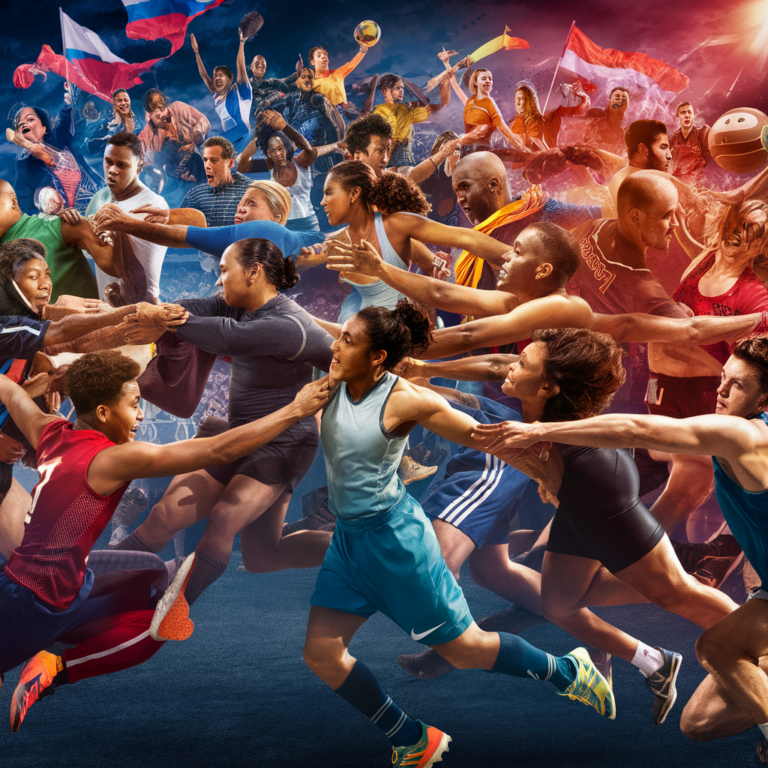The Globalization of Sports: How International Competitions Are Changing the Game
Picture this: a sunny afternoon, the smell of popcorn wafting through the air, and the sound of a distant crowd cheering in unison. I’m sitting in my living room, snacks in hand, glued to the screen watching a soccer match between two teams from countries I could hardly find on a map (seriously, I need to work on my geography). It’s a regular weekend, but this time, I’m not just watching the game; I’m part of something bigger. This is globalization in action, folks, and it’s changing the way we experience sports, whether we’re die-hard fans or casual viewers.
Now, let’s dive into this fascinating world of sports globalization and how international competitions are reshaping the game we all love. It’s not just about players crossing borders; it’s about cultures colliding, traditions blending, and new narratives unfolding. So grab your favorite beverage, settle in, and let’s explore this global sports phenomenon together.
Rising Stars on the Global Stage
Remember when you could easily name five players from your favorite football league? Nowadays, it seems like every other player is from a different country, and honestly, it’s refreshing. Take the English Premier League, for instance. It’s like a United Nations meeting on the pitch! You’ve got stars from Africa, South America, and Asia, all bringing their unique styles and flair to the game. It’s a melting pot of talent, and I, for one, am here for it.
This rise of international players has not only diversified the game but also expanded its reach. Young athletes from all corners of the globe can now aspire to be part of major leagues, and that’s pretty cool. I mean, think about it—little kids in Brazil are practicing their dribbles while watching a match featuring a star from Japan. It’s a beautiful thing when passion knows no borders.
International Competitions: More than Just a Game
International competitions like the FIFA World Cup or the Olympics are like the Super Bowl of sports. They’re not just about the medals or the trophies; they’re about national pride, cultural identity, and yes, sometimes even a little friendly rivalry. I remember watching the World Cup in 2018 and feeling a surge of excitement when underdog teams made it to the knockout stages. It was like watching a reality show unfold, with all the drama, suspense, and unexpected twists.
These big events are also a platform for countries to showcase their culture. The opening ceremonies of the Olympics are not just a parade of athletes; they’re a celebration of history and heritage. When I saw the diverse performances from different nations, I couldn’t help but feel a sense of unity. Sports have this magical ability to bring people together, transcending language, politics, and even time zones (because let’s be honest, who wants to deal with time zones?).
The Impact of Technology and Media
Let’s talk about technology for a minute. Social media has turned every sports event into a global spectacle. Gone are the days when you had to wait for the evening news to catch highlights. Now, I can scroll through my feed and see clips of amazing goals or jaw-dropping saves within minutes of them happening. It’s instant gratification at its finest!
But there’s more! Streaming services have made it easier than ever to watch international competitions from the comfort of our homes. I can binge-watch a series of matches featuring teams I’ve never heard of, all while lounging in my pajamas (which is a serious win). This accessibility has democratized sports viewership, allowing fans from different countries to rally behind their teams and connect with each other.
The Rise of Women’s Sports
Oh, and let’s not forget about the incredible rise of women’s sports on the global stage. The FIFA Women’s World Cup has gained tremendous popularity in recent years, and it’s about time! I vividly recall the thrilling atmosphere during the 2019 tournament—who could forget that epic final between the USA and the Netherlands? The talent, the passion, the sheer will to win… I was on the edge of my seat!
This shift is more than just a trend; it’s a testament to how international competitions are reshaping perceptions of women in sports. Young girls everywhere are now seeing role models who look like them, and that representation is so important. It’s a game-changer, literally and figuratively.
Challenges Amidst the Globalization Wave
But let’s not sugarcoat everything. With globalization comes challenges. The influx of international players can sometimes overshadow local talent, leading to a talent drain in certain regions. I’ve seen young athletes in my neighborhood who dream of making it big, only to find themselves facing stiff competition from seasoned professionals who have moved to their leagues from abroad. It’s a tough pill to swallow, but it’s also a reminder of the need for balance—celebrating global talent while nurturing homegrown heroes.
Additionally, the commercialization of sports can sometimes feel overwhelming. We’ve all seen those cringe-worthy moments when a player pauses mid-game to promote a brand (I mean, really? Can we just play?). The pressure to perform not only on the field but also as a marketable figure can take away from the essence of the game. Let’s keep the focus on the love of the sport, shall we?
Bridging Cultures Through Sports
Now, let’s get a bit philosophical here for a second (don’t worry, I’ll keep it light). Sports have this incredible ability to bridge cultures. They serve as a common language, uniting people from diverse backgrounds. I remember attending a local multicultural sports festival and witnessing teams from different countries competing against each other. It was fascinating to see how each team brought their cultural flair to the games—different cheers, unique styles of play, even traditional outfits. It was like a mini-Olympics right in my hometown!
This blending of cultures is not just enriching; it’s essential. As we move forward in this globalized world, sports can be a unifying force, fostering understanding and camaraderie among nations. Imagine a world where we celebrate our differences while bonding over our shared love for the game. Sounds pretty dreamy, right?
The Future of Sports is Bright
As we look ahead, the future of sports globalization seems brighter than ever. With advancements in technology, we’ll see even more opportunities for cross-cultural exchanges. Virtual reality could allow fans to experience games as if they were in the stadium (I mean, can you imagine sitting in your living room but feeling like you’re right there in the stands?).
Moreover, the emphasis on inclusivity and diversity is likely to continue reshaping the landscape. Sports organizations are becoming more aware of their social responsibilities, advocating for equal opportunities and representation. It’s heartening to see progressive changes taking hold, and I can’t help but feel hopeful about what lies ahead.
Wrapping It Up
So, here we are, at the end of this journey through the globalization of sports. Whether you’re a die-hard fan, a casual observer, or someone who just enjoys the occasional match with friends, it’s clear that international competitions are changing the game in profound ways. We’re witnessing a beautiful blend of cultures, a rise in representation, and a growing sense of community through sports.
And while there are challenges to navigate, the potential for sports to unite us across borders is something to celebrate. So, the next time you find yourself cheering for a team from a country you can’t quite pinpoint on a map, embrace it. You’re part of a global phenomenon, and that’s pretty amazing. Now, if you’ll excuse me, I’ve got some highlights to catch up on…









